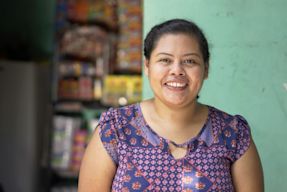How microfinance providers can improve outcomes for women entrepreneurs
March 31, 2022
Women entrepreneurs face formidable challenges at every stage of the enterprise journey, from securing financial backing to balancing household responsibilities to navigating gender-related social norms. COVID-19 exacerbated many of these hurdles, prompting the necessity for microfinance institutions, investors, and development partners to meet the needs of women entrepreneurs in new ways.
To get a better understanding of how to improve solutions and create unique pathways to success, leaders in the microfinance community knew exactly where to source the best information: they asked the women themselves.
Kiva recently published a new report, Catalyzing Innovation for Women Entrepreneurs, based on information provided by 328 women microfinance borrowers in Fiji, Samoa and Cambodia. Created in partnership with the United Nations Economic and Social Commission for Asia and the Pacific (ESCAP), the study focuses on post-COVID realities for women entrepreneurs and offers effective, practical answers on how to better support them.
Almost all those featured in the study say their lives have improved from microloans and report improved outcomes in their households and ventures.
Challenges faced by women micro-entrepreneurs
Study participants ranged in age from 25 to 64, and the majority were married with children. Many of the women—71 percent in Samoa and 82 percent in Fiji—had completed secondary education or higher. When it came to starting a new business, these participants cited certain common barriers:
-
Lack of financial capital
-
Lack of business management and vocational skills
-
Too much competition in their chosen industry
Some of the major challenges to growing existing businesses they reported were:
-
“Time poverty” caused by trying to balance household and business responsibilities
-
Disruptions to business from climate change-related disasters
-
Failure to meet documentation requirements to access formal financing opportunities
Fund a microloan to a woman entrepreneur here
Receiving microloans improved lives
The good news is that in spite of the obstacles most women business owners confront, almost all those featured in the study say their lives have improved from microloans and report improved outcomes in their households and ventures.
One borrower from Fiji described how her loan benefited her business by buying assets including “a boat and a deep freezer and fishing gears. In addition, the home has also improved through renovation and expansion.”
The women also cited the community support that comes with their microloans as a major morale booster. Over 70 percent reported that being a member of a microfinance organization increased their business confidence, while 60 percent said it helped raise their confidence in making decisions in the household.
That supportive self-belief can make all the difference when the difficulties listed above crop up. As one Fijian canteen shop owner put it, “it’s extremely easy to get discouraged when something goes wrong or when you’re not growing as fast as you’d like. Self-doubt creeps in, and you feel like giving up.”
 Penina, a Kiva microloan recipient in Samoa, who makes and sells pancakes in her community to earn a living
Penina, a Kiva microloan recipient in Samoa, who makes and sells pancakes in her community to earn a livingTailoring microlending to better suit women’s needs
While these women entrepreneurs lauded their satisfaction with their loans, they acknowledged that there was plenty of room for improvement from microlending institutions to help start, maintain and grow their businesses. Their suggestions on how to tailor microloans to better suit their needs included:
-
Improving loan terms through lower interest rates and fees
-
Offering more flexible repayment options
-
Increased loan amounts
One example came from a retail shop owner in Fiji who said it would make things easier “if payment can be done after every two weeks due to slow progress of sales in a week.”
Far and away, however, the number one solution called for in the study by these entrepreneurs is access to more training. Ninety percent of those surveyed said they would like to attend a business course, with a focus on management skills and business coaching. Participants also requested other training subjects, such as:
-
Budgeting
-
Business innovation
-
Goal setting
-
Agriculture skills
Such education would support entrepreneurs as well as lenders by increasing the likelihood of paying back loans and furthering new commerce. “[I’m] interested in a training that will bring ideas on how to expand [the] business and venturing into various business[es] without having to fail,” explained one entrepreneur in the study.
In addition to identifying challenges and potential solutions for women entrepreneurs, the report also found that:
-
80% of women entrepreneurs use their home to operate their business
-
When access to financial capital is matched with business management training, women micro-entrepreneurs achieve better business outcomes.
-
Customer-centered approaches to research and product design are essential for designing solutions that can be used to strengthen the socioeconomic capital of women entrepreneurs and their communities.
Lessons for the industry
Although the study was based in three countries in the Asia-Pacific region, the results reflect what Kiva’s partners experience around the globe—and can provide insight for microfinance institutions (MFIs) to bring better financial solutions to women no matter where they live.
“This research-based approach will be critical for microfinance institutions looking to address barriers in entrepreneurship from a gender lens,” said Goldie Chow, former Senior Director of Impact at Kiva.
“We offer up our research findings with the hope that they will empower MFIs with relevant information to directly address women micro-entrepreneurs’ needs as we all work together to recover from the ongoing challenges of the pandemic.”
When it comes to improving women’s entrepreneurial success, microloans have a proven track record. Equipped now with a deeper understanding of those entrepreneurs themselves, investors and lenders can tailor them to further help women to succeed.
PREVIOUS ARTICLE
How the pandemic is affecting small businesses in the Philippines →NEXT ARTICLE
Saffa fled Syria for a better life. A microloan helped her start over. →













